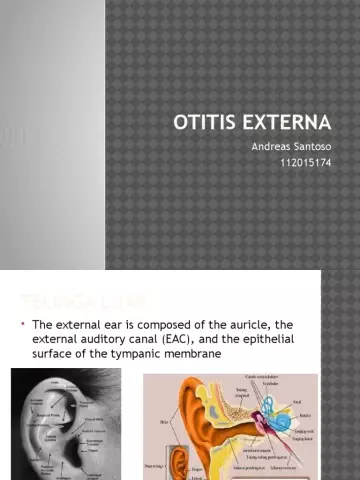- Author Rachel Wainwright [email protected].
- Public 2023-12-15 07:39.
- Last modified 2025-11-02 20:14.
Otitis externa

Otitis externa (otitis externa) is an infectious and inflammatory disease of the external ear canal. This disease develops as a result of damage or removal of the surface protective layer of the ear canal.
Varieties of otitis externa
Otitis externa can develop in acute and diffuse form. Acute otitis externa occurs when the infection penetrates the sebaceous glands and hair follicles located in the fibro-cartilaginous section of the external auditory canal.
Acute otitis externa is divided into primary and secondary. Primary otitis media develops when any violations of the integrity of the skin of the external auditory canal are infected. Secondary acute otitis media develops as a result of burns of chemical and thermal origin. The etiological cause of the disease can be staphylococci, proteus, Escherichia coli, Klebsiella.
Spilled (diffuse) otitis externa most often develops with purulent otitis media in a chronic form as a result of the introduction of various fungi and bacteria into the subcutaneous fatty tissue of the ear canal.
Very rarely, a dangerous complication can develop - malignant external otitis media. This complication occurs as a result of the spread of bacterial infection to the bones located around the ear canal, from where bacteria enter the structures of the base of the skull. This type of otitis externa most often develops with diabetes mellitus, with HIV infection, with a weakened immune system.
Inflammatory reactions in the ear canal and the shell itself can manifest as dermatitis, eczema, perichondritis, hematoma or boils.
Eczema can occur behind the auricle, on the skin around the ear canal. Usually, eczema occurs first from the outside, and then goes inside the auricle. Eczema in acute otitis externa affects the entire surface of the outer ear. With perichondritis, the inflammatory process spreads to the skin, and also captures the cartilage and perichondrium. With the spread of the infection, the auricle may enlarge due to swelling and edema. With an hematoma, the auricle is deformed as a result of a bruise or blunt force hit to the ear region. Often, hematoma occurs in paralyzed people. The essence of the disease is hemorrhage between the cartilage and the perichondrium. Boils in the outer ear can occur when staphylococcus enters the hairline of the skin when combing, using various objects for combing the ear. With otomycomiasis, the ear canal is affected by a fungal infection. When the fungus enters the ear, itching is felt, the top layer of the ear skin flakes off.
Causes of otitis externa
The causes of infection and inflammation of the skin of the ear canal include skin diseases (psoriasis, eczema, seborrhea), allergies, bone growths of the ear canal. Otitis externa can develop with prolonged wearing of headphones, with scratches of the skin of the ear canal from pencils, ear sticks, nails, hairpins, excessive sweating, and also when exposed to shampoo, soap, bath foam.
Risk factors for the development of otitis externa include diabetes mellitus, chemotherapy, organ transplantation, AIDS, working in a humid and hot room, swimming, and the irrational use of ear drops.
Otitis externa symptoms

Symptoms of otitis externa include green or dark gray discharge from the ear canal, hearing impairment, and ear pain. The pain usually increases when the earlobe is pulled back, with pressure on the cartilaginous protrusion in front of the auricle. With otitis externa, swelling and redness of the skin of the ear canal appears, itching in the ear. Very often, with this disease, the lymph nodes increase, the body temperature rises, and a round painful formation appears on the lateral surface of the skin.
Most often, the symptoms of otitis externa, with proper treatment, gradually weaken and disappear.
Otitis externa treatment
If you suspect otitis media at home, you can try to gently rinse the ear canal with warm saline or a mixture of water and white vinegar. You can use over-the-counter medicines (Ibuprofen, Naproxen, Acetaminophen) to relieve itching.
If the pain in the ear has intensified, the skin of the ear canal is swollen, reddened and sore, and the discharge from the ear has an unpleasant odor, then it is necessary to urgently consult a specialist.
For bacterial otitis externa, ointments and antiseptic solutions containing corticosteroids and antibiotics are used. For fungal otitis externa, ointments and antifungal solutions are used.
Treatment of otitis externa in a child
With otitis externa, the child becomes whiny, capricious. He sleeps poorly and complains of ear pain.
With otitis media, the child must be provided with adequate nutrition and complete rest. It is recommended to give your child a multivitamin to strengthen the immune system.
For the treatment of otitis externa in a child, the otolaryngologist usually prescribes 3% alcohol or chloramphenicol and syptomycin emulsion. Gauze turundas soaked in alcohol or emulsion are laid in the ear canal. In the advanced stage of the disease, the doctor may prescribe sulfa drugs and antibiotics.
YouTube video related to the article:
The information is generalized and provided for informational purposes only. At the first sign of illness, see your doctor. Self-medication is hazardous to health!






